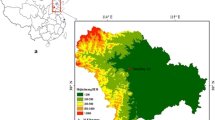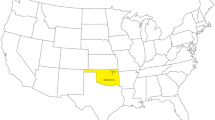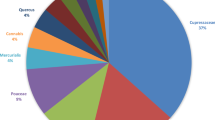Abstract
An important theme related to aerobiology is the spatial distribution of airborne pollen, which is a final goal of our research efforts. In relation to this, pursuing the severity of pollinosis symptoms and problems with airborne pollen and allergens is required. In the past, we simulated the distribution of airborne Japanese cedar (Cryptomeria japonica D. Don) pollen (Kawashima and Takahashi in Grana 34:142–150, 1995, Grana 38:316–324, 1999). The simulation results of recent years will be published in the near future. At the time, it was not possible to compare the results of actual airborne pollen data observed from multiple points at the same time. However, now we can achieve this objective if using C. japonica pollen characteristics. The pollen is dispersed in large quantities over a long distance, remains in the air for a long time, and most airborne pollen at this time is C. japonica pollen. Recently, several automatic C. japonica pollen monitoring systems have been developed and deployed nationwide. Pollen Robo is one and is the most widely installed nationwide. In this study, we addressed Pollen Robo. First, we examined whether Pollen Robo can accurately count C. japonica pollen and found that Pollen Robo was useful during the major pollen season. However, it sometimes counts non-pollen particles and other pollen rather than C. japonica pollen. Therefore, it is not useful when a small amount of pollen is dispersed such as the start day of the pollen season. Next, we examined the daily dispersion of C. japonica pollen and it was shown that it is related to the distance between sampling locations. However, factors other than distance may be involved. Another matter of concern is the relationship between the number of airborne pollen and pollinosis symptoms. Symptoms began to appear from approximately the start day of the pollen season in moderate and light cases. The most serious symptoms occurred when the pollen count was the highest. Meanwhile, in severe cases, symptoms were observed at the time the pollen was scarcely detected and plateaued when the pollen count reached 100 counts/m3 on average over 6 days. Thus, Pollen Robo was not useful when symptoms began in severe cases. This problem was solved using pollen antigen measurement. The time for the symptoms to begin in severe cases is between 2 and 4 weeks before the start day of the pollen season. The amount of Cry j 1 on the start day during some years was considerably larger than that calculated from the number of pollen. The results obtained in this study will be the basic data used for achieving our final goal.





Similar content being viewed by others
References
Aloisi, I., Del Duca, S., De Nuntiis, P., Vega Maray, A. M., Mandrioli, P., Gutiérrez, P., et al. (2018). Behavior of profilins in the atmosphere and in vitro, and their relationship with the performance of airborne pollen. Atmospheric Environment,178, 231–241.
Aoyama, M., & Takahashi, Y. (2004). Development of super-sensitive radical immunoassay for Cry j 1. Arerugi,53, 1088–1090.
Aptowicz, K. B., Pan, Y. L., Martin, S. D., Fernandez, E., Chang, R. K., & Pinnick, R. G. (2013). Decomposition of atmospheric aerosol phase function by particle size and a sphericity from measurements of single particle optical scattering patterns. Journal of Quantitative Spectroscopy Radiative Transfer,131, 13–23.
Buters, J., Prank, M., Sofiev, M., Pusch, G., Albertini, R., Annesi-Maesano, I., et al. (2015). Variation of the group 5 grass pollen allergen content of airborne pollen in relation to geographic location and time in season. Journal of Allergy and Clinical Immunology,136, 87–95.
Buters, J. T. M., Antunes, C., Galveias, A., Bergmann, K. C., Thibaudon, M., Galan, C., et al. (2018). Pollen and spore monitoring in the world. Clinical and Translational Allergy,8, 9.
Buters, J. T. M., Thibaudon, M., Smith, M., Kennedy, R., Rantio-Lehtimäki, A., Albertini, R., et al. (2012). Release of Bet v 1 from birch pollen from 5 European countries. Results from the HIALINE study. Atmospheric Environment,55, 496–505.
El-Ghazaly, G., Moate, R., Cresti, M., Walles, B., Takahashi, Y., Ferreira, F., et al. (1999). Localization and release of antigens from tapetum and pollen grains of Betula pendula. Protoplasma,208, 37–46.
Emilson, A., Berggren, B., Svensson, A., Takahashi, Y., & Scheynius, A. (1996). Localization of the major allergen, Bet v 1 in birch pollen by confocal laser scanning microscopy. Grana,35, 199–204.
Kawashima, S., Clot, B., Fujita, T., Takahashi, Y., & Nakamura, K. (2007). An algorithm and a device for counting airborne pollen automatically using laser optics. Atmospheric Environment,41, 7987–7993.
Kawashima, S., & Takahashi, Y. (1995). Modelling and simulation of mesoscale dispersion process for airborne cedar pollen. Grana,34, 142–150.
Kawashima, S., & Takahashi, Y. (1999). Improved simulation of mesoscale dispersion process for airborne cedar pollen using a flowering time map. Grana,38, 316–324.
Kawashima, S., Thibaudon, M., Matsuda, S., Fujita, T., Lemonis, N., Clot, B., et al. (2017). Automated pollen monitoring system using laser optics for observing seasonal changes in the concentration of total airborne pollen. Aerobiologia,33, 351–362.
Kishikawa, R., Sahashi, N., Saitoh, A., Kotoh, E., Shimoda, T., et al. (2009). Japanese cedar airborne pollen monitoring by Durham’s and Burkard samplers in Japan: Estimation of the usefulness of Durham’s sampler on Japanese cedar pollinosis. Global Environmental Research,13, 55–62.
Matsuda, S., & Kawashima, S. (2018). Relationship between laser light scattering and physical properties of airborne pollen. Journal of Aerosol Science,124, 122–132.
Miki, K., Kawashima, S., Fujita, T., Nakamura, K., & Clot, B. (2017). Effect of micro-scale wind on the measurement of airborne pollen concentrations using volumetric methods on a building rooftop. Atmospheric Environment,158, 1–10.
Miki-Hiroshige, H., Nakamura, S., Yasueda, H., Sida, T., & Takahashi, Y. (1994). Immunocytochemical localization of the allergenic proteins in the pollen of Cryptomeria japonica. Sexual Plant Reproduction,7, 95–100.
Mitsumoto, K., Yabusaki, K., & Aoyagi, H. (2009). Classification of pollen species using autofluorescence image analysis. Journal of Bioscience and Bioengineering,107, 90–94.
Mitsumoto, K., Yabusaki, K., Kobayashi, K., & Aoyagi, H. (2010). Development of a novel real-time pollen-sorting counter using species-specific pollen autofluorescence. Aerobiologia,26, 99–111.
Nutler, F. W. (2010). Weber Fechner law. In N. J. Salkind (Ed.), Encyclopedia of research design (pp. 1613–1615). Ames: Plant pathology and microbiology publications, Iowa State University. https://doi.org/10.4135/9781412961288.n494.
Okamoto, Y., Okubo, K., Yonekura, S., Hashiguchi, K., Goto, M., Otsuka, T., et al. (2015). Efficacy and safety of sublingual immunotherapy for two seasons in patients with Japanese cedar pollinosis. International Archives of Allergy and Immunology,166, 177–188.
Okuda, M., Ohkubo, K., Goto, M., Okamoto, H., Konno, A., Baba, K., et al. (2005). Comparative study of two Japanese rhinoconjunctivitis quality-of-life questionnaires. Acta Oto-Laryngologica,125, 736–744.
Okuda, M., Okubo, K., Gotoh, M., Okamoto, Y., Imano, A., Baba, K., et al. (2003). Standard questionnaire for QOL of Japanese patients with allergic rhinitis. Arerugi [Japanese Journal Allergology],52(suppl 1), 21–56.
Oteros, J., Pusch, G., Weichenmeier, I., Heimann, U., Möller, R., Röseler, S., et al. (2015). Automatic and online pollen monitoring. Allergy and Immunology,167, 158–166.
Ryu, S. (2016). Behavior survey of cedar pollen and allergen Cry j 1 containing particles before and after Asian dust flying. In Outdoor and laboratory survey of the cedar pollen allergens Cry j 1, Cry j 2. Dissertation thesis, Saitama University Graduate School of Science and Engineering (pp. 27–39).
Sahashi, N. (2018). The Cryptomeria japonica pollen front in 2018 & characteristics of C. japonica and Chamaecypari obtuse pollen scattering. Japanese Journal of Palynology,64, 7–17.
Sakurai, D., Yonekura, S., Iinuma, T., Sakurai, T., Morimoto, Y., Mita, Y., et al. (2016). Sublingual immunotherapy for allergic rhinitis: Subjective versus objective tools to evaluate its success. Rhinology,54, 221–230. https://doi.org/10.4193/Rhin15.223.
Sasaki, K., Okamoto, Y., Yonekura, S., Okawa, T., Horiguchi, S., Chazono, H., et al. (2009). Cedar and cypress pollinosis and allergic rhinitis: Quality of life effects of early intervention with leukotriene receptor antagonists. International Archives of Allergy and Immunology,149, 350–358.
Šaulienė, I., Šukienė, L., Daunys, G., Valiulis, G., Vaitkevičius, L., Matavulj, P., et al. (2018). Automatic pollen recognition with the Rapid-E particle counter: The first-level procedure, experience and next steps. Atmos: Atmospheric Measurement Techniques. https://doi.org/10.5194/amt-2018-432.
Suarez-Cervera, M., Takahashi, Y., Vega-Maray, A., & Seoane-Camba, J. A. (2003). Immunocytochemical localization of Cry j 1, the major allergen of Cryptomeria (Taxodiaceae) in Cupressus arizonica and Cupressus sempervirens (Cupressaceae) pollen grains. Sexual Plant Reproduction,16, 9–15.
Takahashi, Y., Aoyama, M., Abe, E., Aita, T., Kawashima, S., Ohta, N., et al. (2008). Development of electron spin resonance radical immunoassay for measurement of airborne orchard grass (Dactylis glomerata) pollen antigens. Aerobiologia,24, 53–59.
Takahashi, Y., Aoyama, M., Yoshitake, M., Abe, E., Ohta, N., & Sakaguchi, M. (2007). Relationship between airborne Cry j 1 and the onset time of the symptoms of Japanese cedar pollinosis patients. Allergology International,56, 277–283.
Takahashi, Y., Kawashima, S., Fujita, T., Itoh, C., Togashi, R., & Takeda, H. (2001a). Comparison between real-time pollen monitor KH-3000 and Burkard sampler. Arerugi [Japanese Journal Allergology],50, 1136–1142.
Takahashi, Y., Kawashima, S., Suzuki, Y., Ohta, N., & Kakehata, S. (2018). Enrichment of airborne Japanese cedar (Cryptomeria japonica) pollen in mountain ranges when passing through a front accompanying temperate low pressure. Aerobiologia,34, 105–110.
Takahashi, Y., Nagoya, T., & Ohta, N. (2002). Identification of airborne pollen and airborne particle with pollen allergen (Cry j 1, Dac g) by aeroallergen immunoblotting technique. Arerugi [Japanese Journal Allergology],51, 609–614.
Takahashi, Y., Ohashi, T., Nagoya, T., Sakaguchi, M., Yasueda, H., & Nitta, H. (2001b). Possibility of real-time measurement of an airborne Cryptomeria japonica pollen allergen based on the principle of the surface plasmon resonance. Aerobiologia,17, 313–318.
Takahashi, Y., Sakaguchi, M., Inouye, S., Yasueda, H., Shida, T., & Katagiri, S. (1993). Airborne grass pollen antigens in a grassland as studied by immunoblotting with anti-Lol p 1 antibody. Grana,32, 302–307.
Takahashi, Y., Sakaguchi, M., Von-Pfaler, M., & El-Ghazaly, G. (2003). Relationship between numbers of birch pollen and different particle sizes of the pollen antigens (Bet v) in the air in Stockholm, Sweden. Allergology International,52, 111–114.
Watanabe, M., Tamura, M., Nagoya, T., Takahashi, Y., & Katagiri, S. (1992). An enzyme-linked immune-sorbent assay for the quantitation of the major allergen from Japanese cedar (Cryptomeria japonica) pollen, Cry j 1, using monoclonal antibody. Arerugi [Japanese Journal Allergology],41, 535–539.
Yamada, T., Saito, H., & Fujieda, S. (2014). Present state of Japanese cedar pollinosis: The national affliction. Journal of Allergy and Clinical Immunology,133, 632–639.
Acknowledgements
We thank Dr. Sahashi, N., the Executive Secretary of the Pollen Information Association, Mr. Nakanishi, H. the Managing Director of “Hanakosan”, and the Atmospheric Environmental Division, Ministry of the Environment of Japan, who permitted the use of the pollen data. We appreciate suggestive comments of two anonymous reviewers. We would like to thank Editage (www.editage.jp) for English language editing.
Author information
Authors and Affiliations
Corresponding author
Rights and permissions
About this article
Cite this article
Takahashi, Y., Suzuki, Y., Ohta, N. et al. Multi-point analysis of airborne Japanese cedar (Cryptomeria japonica D. Don) pollen by Pollen Robo and the relationship between pollen count and the severity of symptoms. Aerobiologia 35, 635–646 (2019). https://doi.org/10.1007/s10453-019-09603-0
Received:
Accepted:
Published:
Issue Date:
DOI: https://doi.org/10.1007/s10453-019-09603-0




